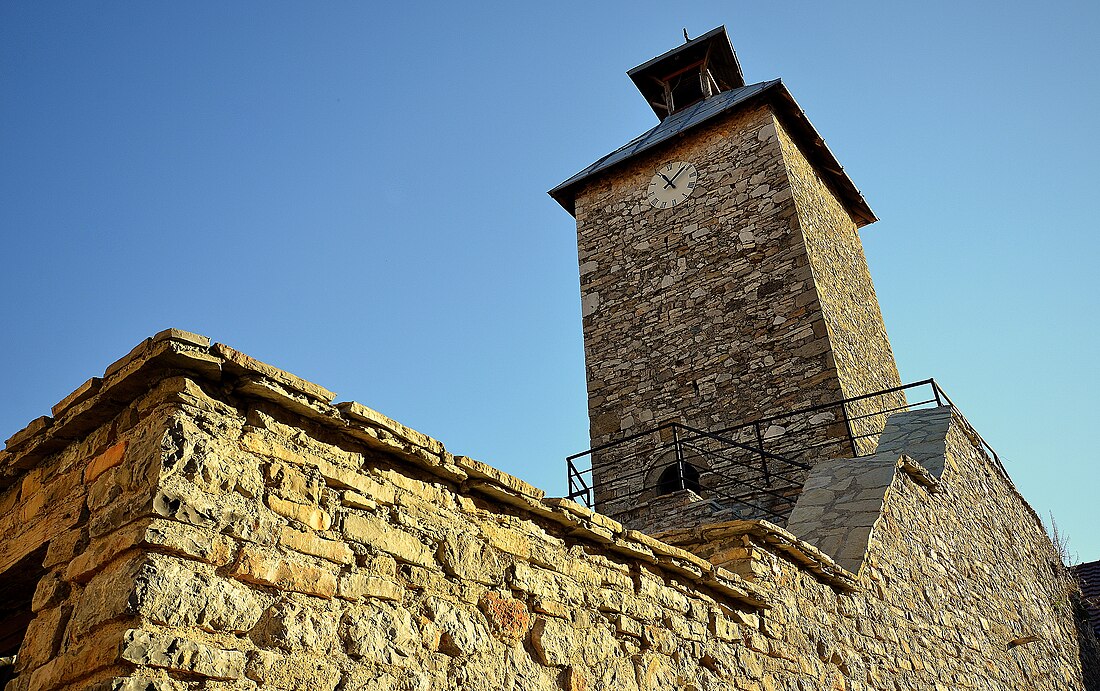Rahovec
Town and municipality in District of Gjakova, Kosovo From Wikipedia, the free encyclopedia
Rahovec (Albanian definite form: Rahoveci) or Orahovac (Serbian Cyrillic: Ораховац), is a town and municipality located in the District of Gjakova in western Kosovo. According to the 2024 census, the town of Rahovec has 13,642 inhabitants, while the municipality has 41,777 inhabitants.
Rahovec
| |
|---|---|
Town and municipality | |
From the top, Panorama of Rahovec, Rahovec Clocktower, Xhamia e Sokolit | |
| Coordinates: 42°23′58″N 20°39′17″E | |
| Country | Kosovo |
| District | District of Gjakova |
| Government | |
| • Mayor | Smajl Latifi (AAK) |
| Area | |
• Municipal | 278 km2 (107 sq mi) |
| • Rank | 21st in Kosovo |
| Elevation | 477 m (1,565 ft) |
| Population (2024)[1] | |
• Municipal | 41,777 |
| • Density | 150/km2 (390/sq mi) |
| • Urban | 13,642 |
| • Ethnicity | |
| Time zone | UTC+1 (CET) |
| • Summer (DST) | UTC+2 (CEST) |
| Postal code | 21000 |
| Area code | +383 29 |
| Vehicle registration | 07 |
| Website | kk |
Etymology
The name of the town and municipality is of Serbian origin and is derived from the Proto-Slavic word orěhъ, meaning nux (English: nut).[2] The name Rahovec comes from an Albanised pronunciation of Orahovac.
Geography and population
The municipality covers an area of approximately 276 km2 (107 sq mi) and contains 35 villages.
Economy
Rahovec is especially known for its vineyards and wines.[3]
Demographics
| Year | Pop. | ±% p.a. |
|---|---|---|
| 1948 | 27,335 | — |
| 1953 | 30,095 | +1.94% |
| 1961 | 35,461 | +2.07% |
| 1971 | 46,788 | +2.81% |
| 1981 | 61,178 | +2.72% |
| 1991 | 85,698 | +3.43% |
| 2011 | 56,208 | −2.09% |
| 2016 est. | 58,908 | +0.94% |
| Source: Division of Kosovo | ||
According to the last official census done in 2011, the municipality of Rahovec has 56,208 inhabitants.
In the municipality's total population, 98.14% are Albanians, amounting to 55,166 individuals, while the rest represent diverse minority groups in Kosovo, including Ashkali, Egyptians, Serbs, Bosniaks and various others.[4]
Local Pidgin Language
The town was known for a language known locally as "Rahovecionshe" or "Raveqki", which is a mixture of Albanian, Serbian and Bulgarian. Its use has declined rapidly after the Kosovo War and nowadays it is nearly extinct.[5] It is thought that this pidgin language developed as a way for Albanian grape farmers to sell their products to wine producers, who were predominately Slavic-speaking.[5]
Notable people
- Shkëlzen Maliqi (born 1947), Kosovo Albanian former politician, born in Rahovec.[6]
- Ajet Shehu (born 1990), English footballer, born in Rahovec .
- Ukshin Hoti (1943–1999), Kosovo Albanian activist, politician, and philosopher, born in Krusha e Madhe.[7][8]
- Ali Sokoli (1921–1974), Yugoslav physician, born in Rahovec.
- Jovan Grković-Gapon (1879–1912), Serbian Chetnik, born in Rahovec.
- Lazar Kujundžić (1880–1905), Serbian Chetnik commander, born in Rahovec.[9]
- Kida (born 1997), Kosovo Albanian female singer
- Xhevdet Bajraj (1960–2022), poet and screenwriter who resided in Mexico.[10]
References
External links
Wikiwand - on
Seamless Wikipedia browsing. On steroids.







